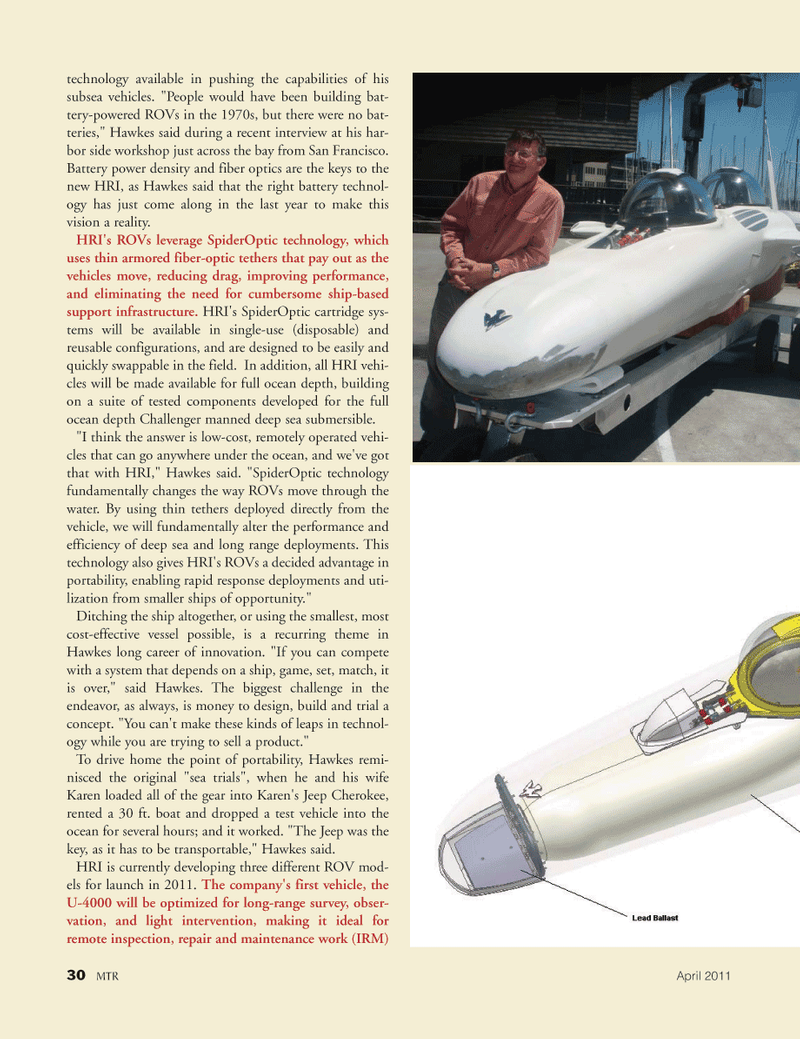
Page 30: of Marine Technology Magazine (April 2011)
Oil & Gas SubSea Monitoring
Read this page in Pdf, Flash or Html5 edition of April 2011 Marine Technology Magazine
30 MTR April 2011 technology available in pushing the capabilities of his subsea vehicles. "People would have been building bat- tery-powered ROVs in the 1970s, but there were no bat- teries," Hawkes said during a recent interview at his har- bor side workshop just across the bay from San Francisco.
Battery power density and fiber optics are the keys to the new HRI, as Hawkes said that the right battery technol- ogy has just come along in the last year to make this vision a reality.
HRI's ROVs leverage SpiderOptic technology, which uses thin armored fiber-optic tethers that pay out as the vehicles move, reducing drag, improving performance, and eliminating the need for cumbersome ship-based support infrastructure. HRI's SpiderOptic cartridge sys- tems will be available in single-use (disposable) and reusable configurations, and are designed to be easily and quickly swappable in the field. In addition, all HRI vehi- cles will be made available for full ocean depth, building on a suite of tested components developed for the full ocean depth Challenger manned deep sea submersible. "I think the answer is low-cost, remotely operated vehi- cles that can go anywhere under the ocean, and we've got that with HRI," Hawkes said. "SpiderOptic technology fundamentally changes the way ROVs move through the water. By using thin tethers deployed directly from the vehicle, we will fundamentally alter the performance and efficiency of deep sea and long range deployments. This technology also gives HRI's ROVs a decided advantage in portability, enabling rapid response deployments and uti- lization from smaller ships of opportunity."
Ditching the ship altogether, or using the smallest, most cost-effective vessel possible, is a recurring theme in
Hawkes long career of innovation. "If you can compete with a system that depends on a ship, game, set, match, it is over," said Hawkes. The biggest challenge in the endeavor, as always, is money to design, build and trial a concept. "You can't make these kinds of leaps in technol- ogy while you are trying to sell a product."
To drive home the point of portability, Hawkes remi- nisced the original "sea trials", when he and his wife
Karen loaded all of the gear into Karen's Jeep Cherokee, rented a 30 ft. boat and dropped a test vehicle into the ocean for several hours; and it worked. "The Jeep was the key, as it has to be transportable," Hawkes said.
HRI is currently developing three different ROV mod- els for launch in 2011. The company's first vehicle, the
U-4000 will be optimized for long-range survey, obser- vation, and light intervention, making it ideal for remote inspection, repair and maintenance work (IRM)

 29
29

 31
31
